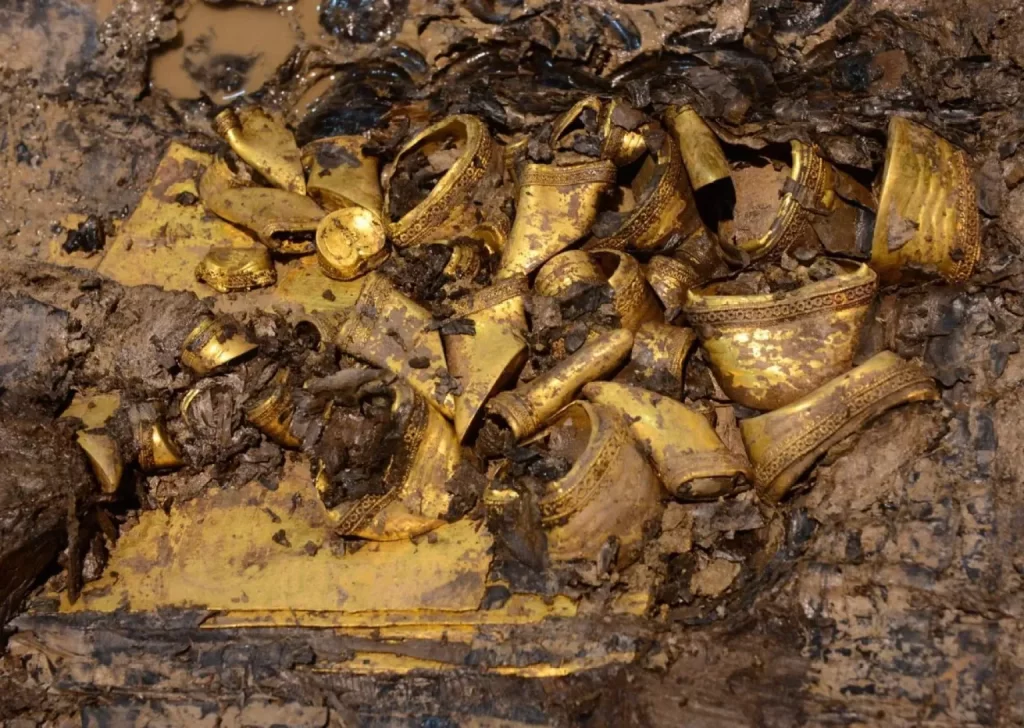Liu He, a historical figure of the Chinese Han Dynasty, reigned briefly as emperor under the era name Yuanping. Before ascending to the throne, he governed the kingdom of Changyi. However, his rule as emperor was short-lived, as he was installed by the influential minister Huo Guang in 74 BC, only to be deposed a mere twenty-seven days later. His removal was accompanied by an extraordinary indictment, citing 1,127 instances of misconduct as justification for his deposition. As a result, he was erased from the official list of emperors, his reign effectively annulled by the Han court.

Following his disgrace, Liu He was stripped of his imperial status and exiled to live as a commoner. His life after exile remained largely undocumented, though records indicate that he died in 59 BC at a relatively young age, likely in his early thirties. Despite his fall from power, he left behind a significant personal legacy, having fathered 22 children and been survived by 16 wives.
Upon his death, Liu He was interred in the tomb of the Marquis of Haihun, located in the northern region of Xinjian, Jiangxi province. This burial site remained undisturbed for centuries until its excavation in 2011, unveiling a treasure trove of historical artifacts that provided remarkable insights into the Western Han Dynasty. Archaeologists uncovered an astonishing 20,000 relics from the tomb, making it one of the most significant archaeological discoveries related to the era.
Liu He’s tomb stands out as one of the best-preserved from the Western Han Dynasty, which spanned from 206 BC to 24 AD. Its structural integrity, unique layout, and comprehensive sacrificial system distinguish it as a rare and invaluable archaeological site. Among the relics retrieved from the tomb are gold, bronze, and jade artifacts, each showcasing the exceptional craftsmanship of the period. The tomb’s findings are particularly notable for their diversity and unparalleled state of preservation, making them among the most significant discoveries ever made in Jiangxi.
One of the most intriguing artifacts found within the tomb was a broken lacquered screen located in the main chamber. Through meticulous restoration, experts managed to piece together two portraits, one of which is believed to be the earliest known depiction of Confucius ever discovered in China. This finding provides a rare visual representation of the revered philosopher, offering invaluable insight into how he was perceived during the Han Dynasty.
Further emphasizing the influence of Confucius’ teachings, over 5,000 bamboo slips containing Confucian classics were unearthed. These texts reinforce the enduring legacy of Confucian philosophy, which had been deeply ingrained in Chinese society for over two millennia. Among these ancient writings, scholars discovered the Qi version of The Analects of Confucius, a long-lost edition of the text that had been missing for approximately 1,800 years. Through advanced infrared scanning techniques, these bamboo slips have been carefully preserved and prepared for further scholarly study, potentially shedding new light on Confucian doctrine as it was understood in ancient China.
Although Liu He’s life was marked by political disgrace, his burial site tells a different story—one of immense wealth and imperial grandeur. The vast collection of gold artifacts discovered in his tomb represents the largest single hoard of gold ever found within a Han Dynasty burial site. This extraordinary find attests to the vast gold reserves of the Han Empire, demonstrating the dynasty’s economic strength and sophisticated trade networks.
The tomb also presents a unique insight into ancient burial customs, as it is the only Han-era tomb south of the Yangtze River to feature a dedicated chariot burial site. Within this section of the tomb, archaeologists uncovered five remarkably well-preserved horse-drawn chariots, each accompanied by the remains of four sacrificed horses. The presence of these chariots underscores Liu He’s high status within the Han aristocracy, as such elaborate burial practices were typically reserved for individuals of great political and social significance.
Liu He was the grandson of Emperor Wu, a formidable ruler whose reign marked a golden age of the Han Dynasty. Emperor Wu’s rule is often considered one of the most prosperous in Chinese history, rivaling the grandeur and influence of the First Emperor of the Qin Dynasty. His expansionist policies, cultural advancements, and administrative reforms solidified the Han Dynasty’s power, setting the foundation for centuries of Chinese governance.
The significance of the Haihunhou tomb extends beyond Liu He’s personal history. According to Yang Jun, a lead researcher at the Jiangxi Provincial Institute of Cultural Relics and Archaeology, the tomb fills a crucial gap in the study of Emperor Wu’s era. While the Terra-cotta Warriors serve as a window into the world of Qin Shi Huang, archaeological evidence from the Han Dynasty has historically been limited. The discovery of Liu He’s tomb has provided scholars with an invaluable opportunity to examine the material culture of the Han court in greater depth.
Through its extensive collection of artifacts, Liu He’s tomb offers a compelling narrative of the grandeur of the Han Dynasty, preserving the artistic, philosophical, and political influences of the era. The relics recovered from the site serve as a tangible connection to a transformative period in Chinese history, shedding light on the intricate customs, sophisticated craftsmanship, and intellectual legacy of the Western Han rulers.
Though Liu He’s reign was short and his political downfall severe, the discoveries made in his final resting place reveal a dynasty at its height. The artifacts speak to a time of immense wealth, cultural richness, and scholarly advancement, highlighting the enduring influence of the Han Dynasty in shaping China’s historical legacy. Through continued excavations and scholarly analysis, the tomb of the Marquis of Haihun continues to offer profound insights into the ancient world, bridging the past with the present and deepening our understanding of one of China’s most influential dynasties.





